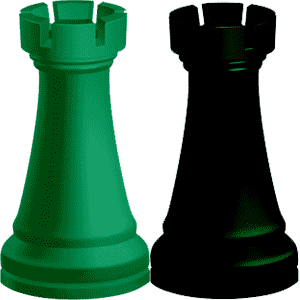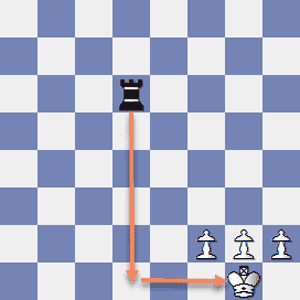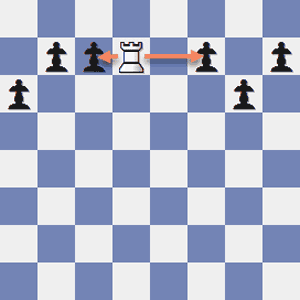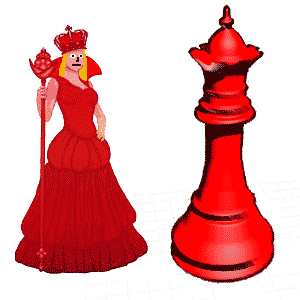Learn The Rook Moves For Chess

We can focus on how the Rook moves now that the Bishop has been dealt with. The Rook is the second most powerful piece on the board and you start with two of them.
You don't tend to see the Rook feature much in the opening exchanges except for the special castling move. That maneuver is primarily to get the King away from danger but it also helps move a Rook towards a central position on the back rank.
We'll just take a look at where the Rook starts the game and then move on to his movements. It is worth appreciating the main attacking attributes that a Rook brings to the table.
Initial Setup
































































Rook Moves - Each side starts with two Rooks placed on the four corners of the board
As you can see the Rooks start the game in the corner squares. They remain largely inactive for the early part of the game. The only action involving Rooks in the first 10 to 12 moves is usually the castling of the King.
The minor pieces move out and the Queen is stationed safely on the second or third rank. During the opening the castling generally takes place. At this stage you often see just the King and his two Rooks, now connected as a battery, on the home rank.
It is generally advisable to keep the Rooks at home until later in the game. Here the now doubled Rooks will watch over the King and give each other mutual protection.
Straight to the Point

The Rook moves along the ranks and files. ...Rd1# mates the King
The Rook's move compliments that of the Bishop in many ways. The Bishop moves on the diagonals in all directions with unlimited range excepting roadblocks. The Rook has the same deal only on the straights.
This makes the Rook an extremely dangerous piece that can inflict a lot of damage on enemy forces. It is not a good idea to bring the Rook into the battle in the opening moves. There is too much traffic on the board and the Rook cannot be effective.
The trick is to keep your powder dry with the Rooks and wait until the files start to empty. As the game wears on and more pieces leave the board, the battleground becomes more open. This is the ideal environment for Rooks to get maximum mobility and start bearing down on your opponent.
Rook is Such a Pig

Rook Moves - If you get a Rook on to the seventh rank he is sometimes described as a pig
One way to inflict damage on the enemy is if your Rook moves to the 7th rank. This is not always possible but it's a good plan if the opportunity arises. This can happen in the middlegame or even in an endgame with multiple pawns.
Such a Rook is often referred to as a pig. This is because he can then start taking out hopefully defenseless pawns on their starting blocks like a pig gorging swill from a feeding trough. Two Rooks on the 7th can threaten checkmate against a King trapped on the home rank.
If you can pick up some pawns like this it can have a major bearing on the outcome of the game. Pawns become so important in the endgame that every last one is crucial to the cause.
Castling Specialties
































































Rook Moves - The King and Rook can perform a special castling move one time in the game
One of the early objectives in the game is to get the King safe from the opposing forces. This means he should be quickly moved from his precarious starting central position to the relative safety in one of the corners. A special castling move is designed specifically for this purpose.
So why are we talking about this now. Well the reason is it involves a Rook. First off there are a few things to clear up on this. A King can be castled to either side, short to the Kingside or long to the Queenside. The King moves two squares to his right or left and the relevant Rook is moved one square past the King toward the center.
There are a few things that need to be satisfied to make castling legal. You can only castle if the both the King and the Rook involved have not yet been moved. There must be no other piece positioned between Rook and King.
The King cannot be in check when the maneuver takes place or obviously upon it's completion. Finally no square that the King crosses when castling can be controlled by an enemy piece. In the diagram White has castled long and Black has castled short.
The King cannot be in check when the maneuver takes place or obviously upon it's completion. Finally no square that the King crosses when castling can be controlled by an enemy piece. In the diagram White has castled long and Black has castled short.
Moving On

So bottom line is the Rooks move straight in any direction. They have unlimited range and can move as far as there is no friendly piece blocking their path or enemy piece to be captured. Play through the demonstrations in the Rook tutorial.
The Rooks are quite valuable and can cause serious destruction to the enemy camp when you move into the business end of the game. The most common endgames in chess are incidentally Rook and pawn endgames. That's a King, Rook and some pawns vs a King, Rook and some pawns. So get handy with those Rooks!
This all brings us on to one of the real stars of the chess show. She is the most powerful piece in chess and a big part of your attacking plans. You know it's the Queen.

